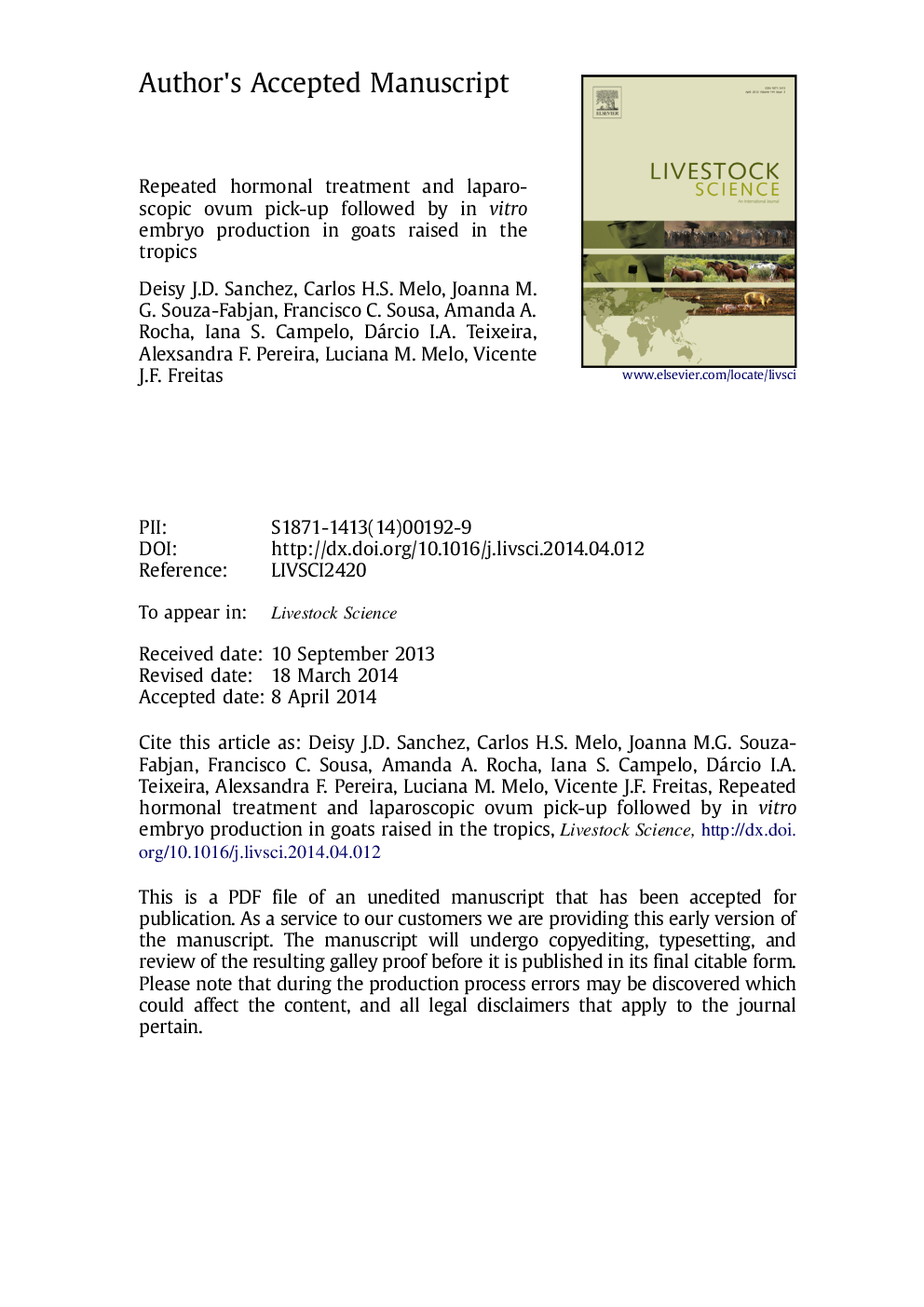| کد مقاله | کد نشریه | سال انتشار | مقاله انگلیسی | نسخه تمام متن |
|---|---|---|---|---|
| 5790118 | 1553967 | 2014 | 21 صفحه PDF | دانلود رایگان |
عنوان انگلیسی مقاله ISI
Repeated hormonal treatment and laparoscopic ovum pick-up followed by in vitro embryo production in goats raised in the tropics
ترجمه فارسی عنوان
درمان هورمونی تکراری و برداشتن تخمک لاپاروسکوپی و سپس تولید جنین درون زیستی در بز های بلند در مناطق استوایی
دانلود مقاله + سفارش ترجمه
دانلود مقاله ISI انگلیسی
رایگان برای ایرانیان
کلمات کلیدی
موضوعات مرتبط
علوم زیستی و بیوفناوری
علوم کشاورزی و بیولوژیک
علوم دامی و جانورشناسی
چکیده انگلیسی
The objectives of this study were to evaluate the ovarian response of oocyte donor goats which underwent seven repeated ovulation hormonal treatments and laparoscopic ovum pick-up (Experiment 1), and to compare the In vitro production (IVP) of embryos from goats hormonally treated for eighth time to IVP of embryos from females with a single hormonal treatment (Experiment 2). In Experiment 1, 12 goats were subjected to 7 repeated hormonal treatments and laparoscopic ovum pick-up (LOPU) every 2-3 weeks, and the following variables were recorded: number and size of punctured follicles, number of recovered cumulus-oocyte complexes (COCs), recovery rate and COCs quality. In Experiment 2, IVP of embryos from goats hormonally treated for eighth time (repeated-treated group, RT) was compared with IVP of embryos from 10 other goats with only one hormonal treatment (single-treated group, ST). In this step, in addition to variables observed in Experiment 1, cleavage, blastocyst rates at Days 7 and 8 of culture, hatched rate and the number of blastomeres per embryo were also evaluated. In Experiment 1, when comparing LOPU sessions, no difference (P>0.05) was verified for number of punctured follicles, number of recovered COCs and recovery rate. However the percentage of large follicles was different (P<0.05) between LOPU 1 (27.7±10.5) and 7 (12.4±12.1), the latter being similar to sessions 2 (13.9±10.9), 3 (13.4±7.9), 4 (13.2±10.7), 5 (22.4±14.7) and 6 (17.7±15.8). The percentage of COCs suitable for IVM was lower (P<0.05) for LOPU 1 (80.6%), 2 (82.4%) and 3 (79.7%) than LOPU 6 (91.3%) and 7 (95.2%). In Experiment 2, total number of follicles aspirated/goat and total number of COCs recovered were similar (P>0.05) for RT (18.0±5.8 and 12.3±3.7, respectively) and ST (19.4±7.8 and 15.8±7.7, respectively) groups. However, the recovery rate was lower (P<0.05) in the RT vs the ST group (68.5% and 81.4%). The percentage of small, medium and large follicles was similar (P>0.05), respectively, for RT (28%, 55% and 17%) and ST (20%, 65% and 15%) groups. The percentage of COCs suitable for IVM had no difference (P>0.05) for RT (96.6%) and ST (93.7%) groups. No significant difference was observed between RT and ST groups for: cleavage rate (68.6% vs 67.0%), blastocyst rate at Days 7 (27.9% vs 31.8%) and 8 (27.9% vs 34.1%), hatched rate (33.3% vs 53.3%), and blastomeres/embryo (252.9 vs 229.8). In conclusion, in goats raised in tropical climate, the IVP of embryos from oocytes obtained by LOPU could be an efficient and suitable method for rapid propagation of genetically superior animals. Donor goats, even after repeated hormonal treatments followed by LOPU, maintained the ovarian response for oocyte and embryo production, becoming close to reality the term “oocyte permanent donors”.
ناشر
Database: Elsevier - ScienceDirect (ساینس دایرکت)
Journal: Livestock Science - Volume 165, July 2014, Pages 217-222
Journal: Livestock Science - Volume 165, July 2014, Pages 217-222
نویسندگان
Deisy J.D. Sanchez, Carlos H.S. Melo, Joanna M.G. Souza-Fabjan, Francisco C. Sousa, Amanda A. Rocha, Iana S. Campelo, Dárcio I.A. Teixeira, Alexsandra F. Pereira, Luciana M. Melo, Vicente J.F. Freitas,
